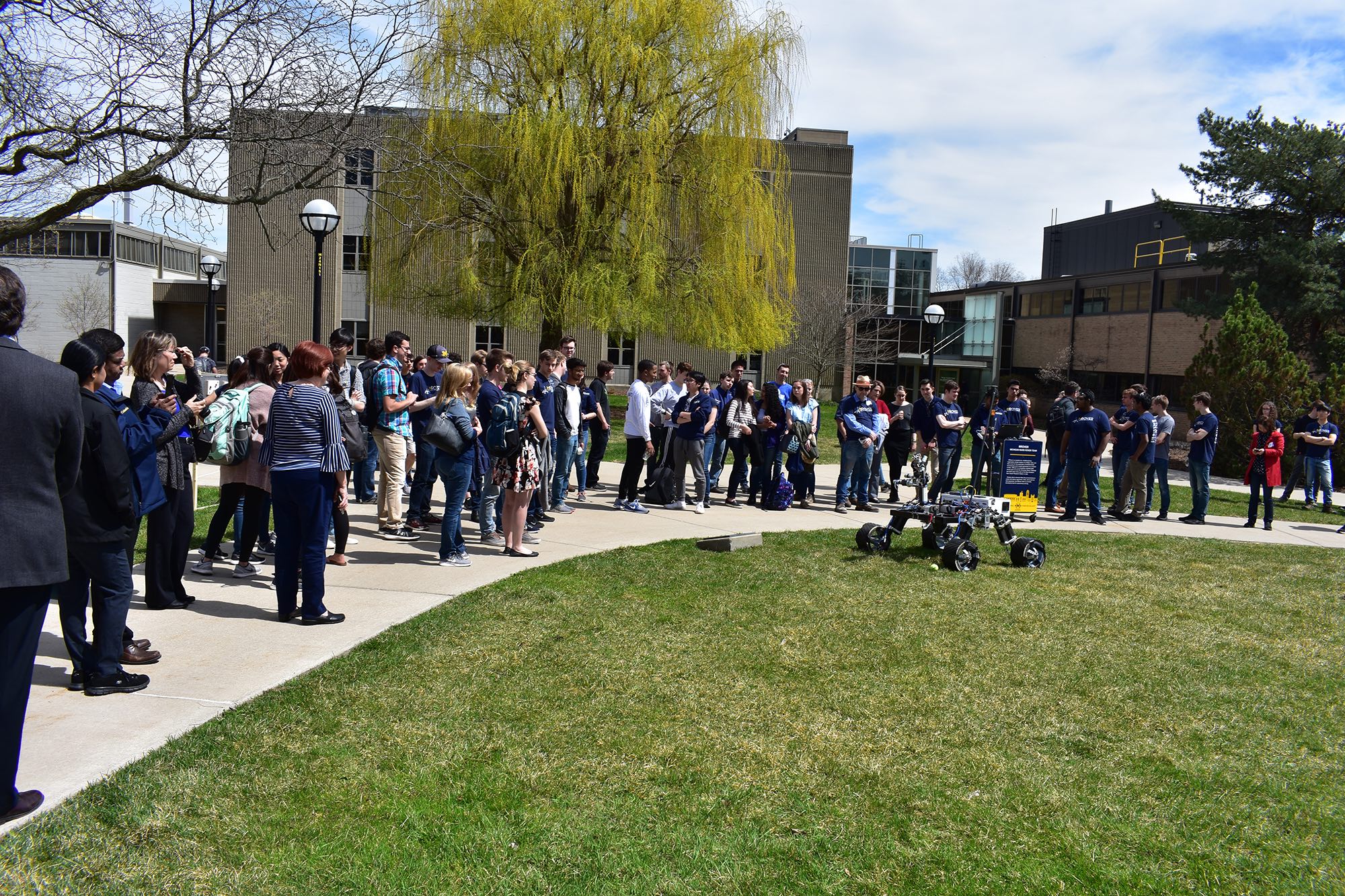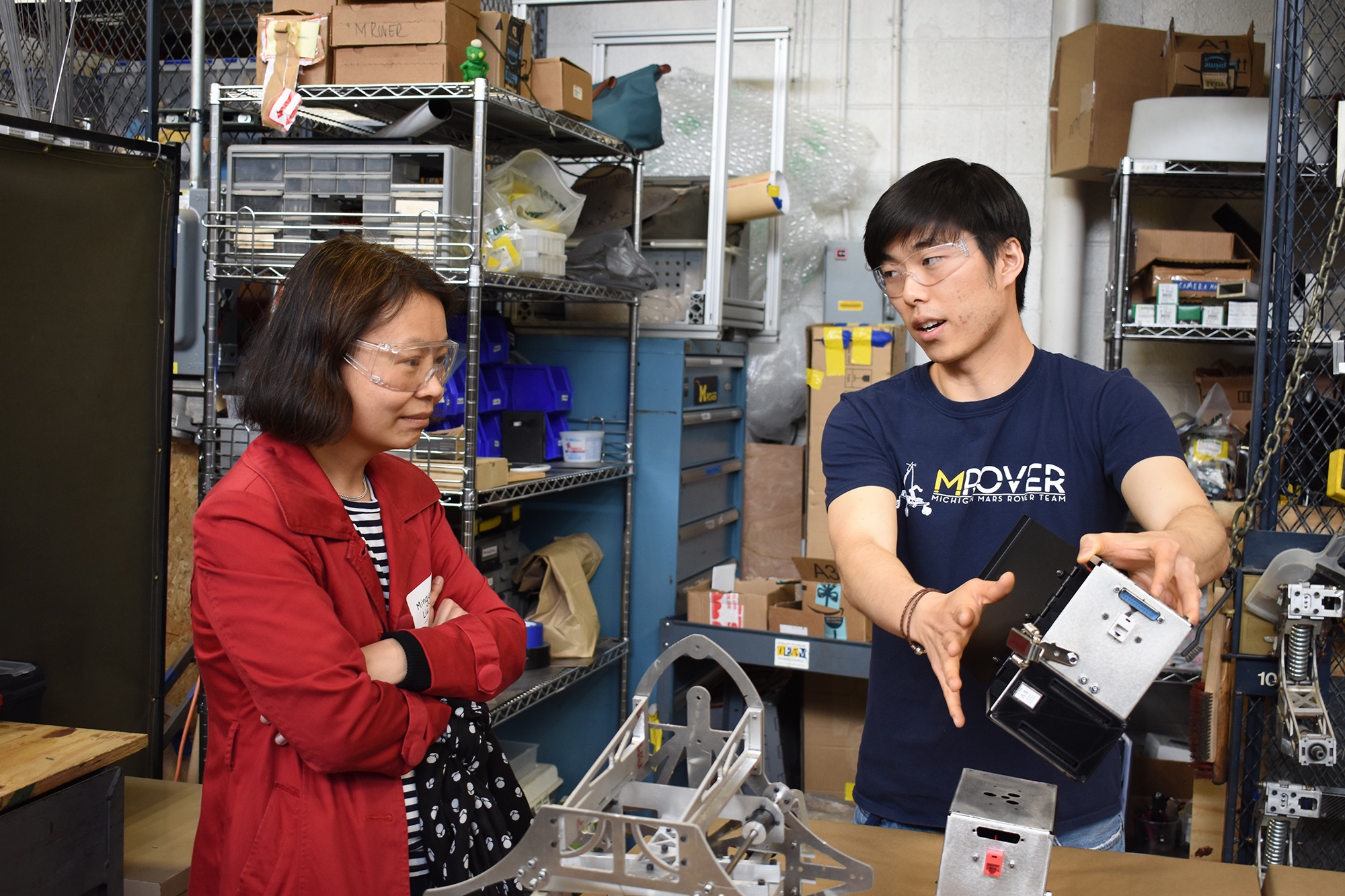Michigan Mars Rover Team has best ever finish at the annual University Rover Challenge
MRover placed 7th overall at the annual challenge where rovers use AI to navigate tough terrain while collecting soil samples to practice testing for evidence of life in the universe.

 Enlarge
Enlarge
This summer – out on the wide, expansive, red desert plains of Utah, far from evidence of human civilization – the Michigan Mars Rover Team (MRover) competed against teams from all over the world to advance the tools for the exploration of other planets.
The University Rover Challenge (URC) is hosted by The Mars Society, the largest advocacy group for the exploration and settlement of Mars. It takes place at the Mars Desert Research Station in the Utah Desert, and it consists of four main challenges that test the rover’s ability to function over difficult, uneven terrain, operate complicated tasks with a robotic arm, autonomously localize and navigate the area, and – ultimately – test soil samples for signs of life.
Only 36 teams can compete in the URC. This year, MRover placed 7th overall and 4th in the U.S. while receiving a perfect score in the science task. They also received the highest score for their video that all teams are required to submit to get into the tournament.
“I’m incredibly proud of what the team has accomplished this year with the support of so many people and ideas,” says Michelle Gehner, a sophomore in EE who will serve as president of MRover this coming year. “By going through a huge team growth and achieving our technical goals, we were able to see our hard work in building the rover pay off in URC 2019.”
The goal of the competition is to help further the design and operation of rovers to help future astronauts explore new worlds. While the rovers don’t actually go to Mars, students have the opportunity to win prizes and be invited to other competitions and conferences that will help them learn more about space exploration.
“There’s a romance to space exploration,” says Karthik Urs, a senior in CE and ME who’s been a member of MRover since he was a sophomore. “But I also love the engineering aspects. Space poses challenges that are completely different than on earth that require some very clever engineering solutions.”

 Enlarge
Enlarge
MRover consists of four main teams. The mechanical team is responsible for the rover’s mobility and chassis, as well its robotic arm and the tools needed for it to drill into the rocky landscape and to collect and soil samples. The software team works on autonomous navigation and computer vision, for the rover needs to identify markers and obstacles from as far away as possible and then navigate a path through the area.
The electrical team designs and builds the rover’s circuits and power boxes, and they are responsible for ensuring that there is a strong wireless communication between the rover and the base camp. The science team is responsible for selecting the probes and other tools that will be onboard the rover and used for testing environmental conditions. The science team uses satellite imagery to select the site where the rover will take its samples, and they test then the samples onboard for evidence of carbon and carbohydrates, or other biomolecules.
“There’s a lot that we don’t know about the material – and the extraterrestrial material – of other planets,” says Gehner. “That’s why I really wanted to learn about how to engineer better ways to create instruments that will help us explore other worlds.”
“Designing rovers is a really unique experience,” says Matt Price, a senior in CE. “It’s not like you see them everywhere. You don’t just drive around and go, ‘oh, there’s a rover.’”
MRover is comprised of around 100 students (mostly undergrads) from all over the university. The multi-disciplinary nature of the URC requires expertise in different engineering disciplines, but also environmental science, astrobiology, climate and space, and others. Business and IOE majors are also a key part of MRover, for the group is entirely student-run, and they do all their own budgeting and fundraising.
“It’s very representative of the industry and space engineering/space robotics, because the engineers serve the scientists,” Urs says. “The scientists are thinking of wacky new things to find on these other planets, and the engineers have to figure out how to make it happen.”
While the diversity of expertise is important to MRover, they have also committed to ensuring a diversity of personnel. 40% of members are women, and the incoming executive board is 80% women.
“It’s a fact that women are underrepresented within the field,” Gehner says, “but that tide is changing. I’m really proud of the culture of our organization.”
“Our goal is to at least be representative of the College of Engineering in terms of diversity distribution, but to soon surpass that would be fantastic,” Urs says.

 Enlarge
Enlarge
In addition to time spent together building the rover, the team hosts social events to promote a fun, collaborative, and supportive environment. They paint the rock together, host game nights, play laser tag, and this past year they went to a haunted orchard.
“I was really impressed by the team chemistry,” says Srinidhi Krishnan, a freshman in CE. “When I joined, the leadership really made sure that we all felt welcome and we didn’t feel behind or anything like that. I met some of my best friends on Rover.”
One of the biggest bonding experiences is the competition itself, which begins with a two-day caravan across the country.
“Being stuck in a minivan with people is a great way to get to know them,” Price says.
The actual competition takes place over three days and always involves last minute issues that require on-the-fly-solutions. Last year, Urs and another team member spent most of the night in a work van using a heat gun to repair a broken epoxy bond that would normally take a week to set. Their improvisation worked, and the rover was able to compete again the next day.
“No matter how we do at the competition, it’s just a great feeling,” Price says. “You spend all year building this thing, and then you see all your work come to fruition and see the rover do what it’s supposed to do.”
It’s these kind of experiences that members say have strongly helped to augment their education.
“A lot of the people who are in our organization now are learning the skillsets that’ll help them be on the front foot of the space exploration field,” Gehner says.
A lot of the people who are in our organization now are learning the skillsets that'll help them be on the front foot of the space exploration field.
Michelle Gehner, MRover President-Elect
Krishnan and Price both say they’ve not only been able to apply knowledge they’ve learned in class to the rover, but they’ve also been able to apply skills they’ve gained from MRover to class projects. Urs, like several other members of MRover, has spent the last two years interning at the NASA Jet Propulsion Laband working on the real Mars 2020 Rover, for which he says MRover has significantly helped prepare him.
“It’s surprising how similar some challenges are that we face on our 50-kilogram rover compared to the $2 billion 1,000-kilogram rover,” Urs says.
While the team gears up for the future, Price, who graduated this spring, reflects on how this year’s competition will be his last.
“The people in MRover really shaped my college career,” he says. “I didn’t have a lot of friends freshman year, but then I got to know people on MRover, and it’s such a great group of people and a close-knit community. I had a lot of fun getting to know everyone.”
MRover is advised by U-M Dearborn Prof. Line van Nieuwstadt, who also serves as an Adjunct Research Scientist for Climate and Space Sciences and Engineering.








 MENU
MENU 
